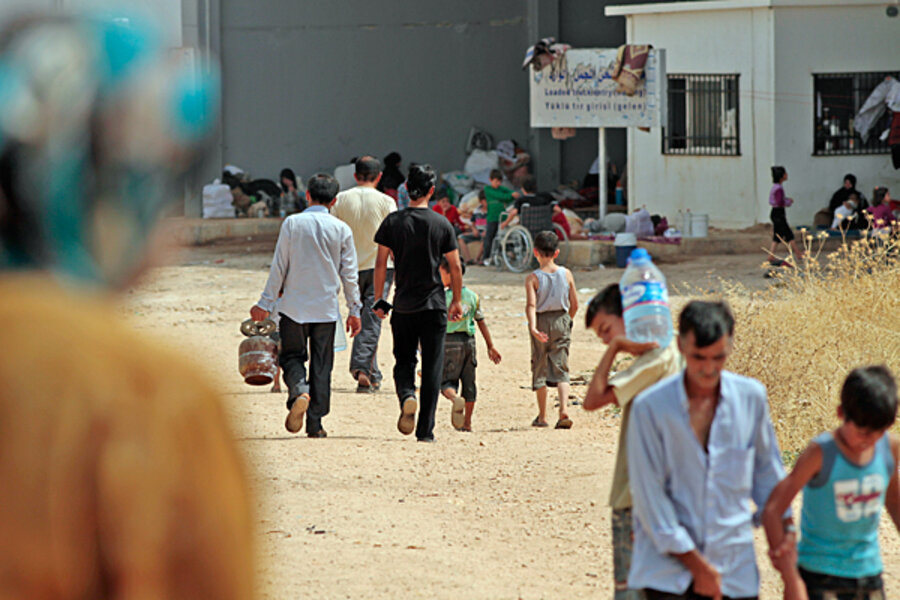Amid squalor and fear on Turkish border, Syrians make plea for safe zone
Loading...
| Bab al-Salama, Syria
In this camp that has sprung up along the Turkish border, 5,000 Syrians who have fled their country's civil war live under covered vehicle lanes on an unfinished section of the Syrian border, waiting to cross into Turkey or return to their homes. Sleeping out in the open on asphalt and scrounging for clean water, they hope that they will be allowed into Turkey, where they can find a truly safe haven in an established refugee camp.
But Turkey, overwhelmed by a surge of Syrian refugees, is instead expected to call on the United Nations today to create a safe zone inside Syria to stem the tide coming over the border.
A safe zone along the border would offer Turkey a place to redirect refugees, but a number of political complications make the formation of such an area unlikely – a reality all too familiar for thousands of beleaguered Syrian refugees unable to enter Turkey or escape the violence in Syria.
“The safe zone is a dream. It will not happen. The world is against us,” says Abdul Qadir Haj, a former Syrian policeman who fled to a camp near the Bab al-Salama border crossing into Turkey, a short drive from Aleppo. The camp is now home to about 5,000 refugees.
In just the past two weeks, the refugee issue has exploded in Turkey and Jordan, the other major recipient of Syrian refugees. Previously Turkey received about 400 to 500 Syrians each day, but those numbers have recently climbed to as many as 5,000 per day, according to the UN.
Some 80,000 refugees are now in Turkey, and UN officials say those numbers could reach 200,000 if the conflict continues to escalate. Already there are an estimated 2.5 million people inside Syria who need humanitarian assistance and 1.2 million who are internally displaced.
Turkey originally said it could host no more than 100,000 refugees, but the construction of several new refugee camps has increased its capacity to 150,000. Concerned about absorbing such a high number of refugees, Turkey has been among those in the international community pushing hardest for the creation of a safe zone inside Syria.
Even without the creation of an official safe zone, much of the area along the border with Turkey is now under the control of the Free Syrian Army. The opposition group now controls the Bab al-Salama border crossing and many of the towns north of Aleppo.
The absence of government forces means there is little fighting in the area, but those who have fled say the area remains unsafe as long as Syrian government forces have airplanes and artillery.
In Azzaz, a town just a few miles from the border crossing and refugee camp, locals say government planes have bombed several buildings in recent weeks. Other towns in the area surrounding Aleppo face regular artillery fire and aerial bombardment. There are also concerns about unofficial militias attacking residents.
“We want a safe zone. The planes can come here at any time and bomb us. Right now it’s only safe inside Turkey,” says Zahara Umm Hasa, a widow who fled to the Bab al-Salama refugee camp about two weeks ago.
With the threat of bombing still looming, there are few humanitarian organizations offering assistance.
Meanwhile, those inside the camps say conditions are worsening as the number of refugees increases. In the Bab al-Salama camp, refugees live under the shaded sections of visa processing lanes in an unfinished section of the Syrian border crossing. Families have rolled out woven plastic mats to make sitting and sleeping on the asphalt slightly less uncomfortable.
Aside from a few lucky families who sleep in small rooms intended intended for passport police, refugees sleep shoulder-to-shoulder under a concrete roof that provides relief from the sun, but no other protection from the elements.
The few humanitarian groups working in the camps provide medicine and food. Local vendors from nearby towns also visit the camp to sell food and other items. Although refugees say they have enough food for now, they complain that there is limited access to clean water.
With refugees crowded together with extremely limited sanitation facilities, the squalor has led to health problems, especially for children. Refugees say they've only met one doctor in the camp who can help those who fall ill, and he seldom has enough medicine to treat all those who need it.
“We work in danger here. We are close to the bombing,” says Osman Atalay, a board member for the Foundation for Human Rights and Freedom and Humanitarian Relief, a Turkish humanitarian organization that is among a small handful providing assistance to Syrian refugees at the Bab al-Salama border crossing. “There are many organizations who want to help. If they make the decision to create a safe zone maybe more will come.”
To be truly protected, the safe zone would need to be accompanied by an internationally imposed no-fly zone, which would prevent the possibility of air strikes. But the international community remains unwilling to create a no-fly zone in Syria, despite strong support from France. Additionally, while the FSA has control of much of the border region, it remains unclear how capable they would be of protecting a safe zone in the event of an attack.
“The FSA cannot protect all the people here because the regime still has many supporters," says Saleem Shams, a student from Aleppo University currently in the refugee camp, who worries that there may be dormant pro-government supporters who would help in such an attack. "There is no reason to stay in our cities because there is no way to study or work,” he adds.





